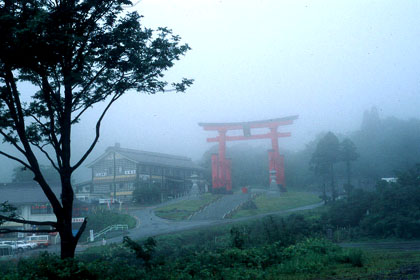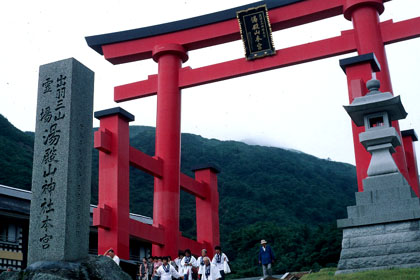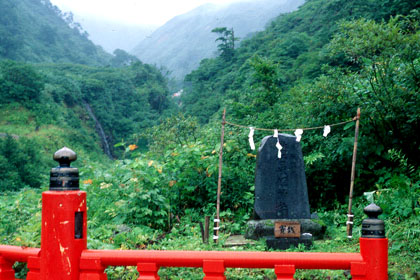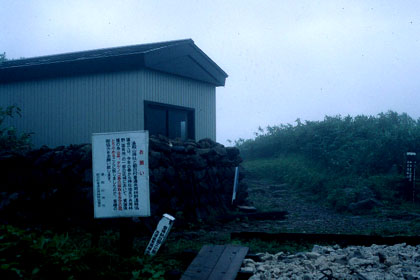|
Akita
I take a local train from Tazawa-ko to Akita via Omagari. The train passes through the most beautiful, dense and verdant forest I've seen anywhere in Japan. The rain only adds to the sense of green here. Steep, tree-covered hills rise from flat valley floors. The fields here are so flat it is as if the farmlands were poured into the valleys as liquid, then allowed to settle into lakes of greenery. And in geological terms perhaps this is exactly what has happened; these are very old river valleys between steep and eroded hills, the products of eons of river meanderings, yearly torrents of rain and the resultant mudslides that have filled the valley floors with rich, fertile soil. In many respects the geology of this place reminds me of the upper Skagit valley, north of Seattle, where steep eroded and forested slopes also end abruptly in a flat valley floor. The train makes a long stop at Kakunodate, where it quickly fills with high-school aged boys and girls in school uniforms. The girls wear white and blue plaid skirts with modest sailor-style blouses. The boys wear dark blue pants and simple white shirts with short sleeves. Out of school now, the boys pull the tails of their shirts out of their pants and jostle around the train car, never sitting still. They carry a diverse collection of scuffed backpacks and courier-style shoulder bags. To a one, the girls carry identical blue and brown book bags. Akita -- another medium-size Japanese city, virtually indistinguishable from Morioka, Kagoshima, Sendai... It continues to rain. After pondering the train schedules I make the decision to stay here for the night rather than continuing south this late in the day. The Akita Mediterranean hotel is one of the better hotels near the station. Itís not cheap, but at $70 for the night itís not terribly expensive either. After checking in (and letting a bellboy carry my backpack up the elevator), I go out for hot soba and tempura, then a quick walk around downtown. Iím in bed by 10:30. Dewa Sanzen In the Akita station at 7:30AM, I arrange a ticket south to Tsuruoka, which is near a cluster of small peaks laced with hiking trails, according to a hiking book Iíve brought from the states. The train does not leave for another hour, so I find a small cafť in the station and have a coffee, juice and a pastry. Between 7:30 and 8:30 the station is mobbed with students, boy-men and girl-women in their high school uniforms. If these uniforms are an attempt by the government and school administrators to perpetuate a cultural conformity, then it appears to be a fruitless attempt. Look closely at a group of high-school age Japanese and you can see the individual choices that define each studentís self-image. Start with the shoes: where one girl wears conservative low black pumps, another has made a direct challenge to authority by wearing hipster-style ankle-high boots with three inch thick soles and bulbous toes. Other girls accentuate their legs by wearing baggy white leggings that slump down over the tops of their shoes and accordion in loose folds halfway up their shins. The effect is more than mildly suggestive, looking rather like a pair of tights that have been pulled down to the ankles. Often combined with this subtle fashion statement is the somewhat more explicit practice among older girls of wearing a regulation skirt that is two or three sizes too small, and that therefore rides a good four inches too high on the waist and correspondingly higher at the thigh... But although certain powers within the government and among the school administration may attempt to squelch such behavior, the Japanese culture (like every other first-world culture) does everything in its mindless power to promote the early sexualization of its women. Magazines for young women here are filled with the same image-focused ads and articles ("Bust Up Cream!"), the same pouting supermodels, the same implicit valuation based on potential for sexual arousal as found in any copy of 17 Magazine or Cosmopolitan. My train arrives and, regrettably, Iím forced to leave the throngs of future housewifes and salarymen (and supermodels and gansters?) and get on board. The train from Akita to Tsuruoka, the Hokuto Limited Express, travels along the Japan Sea coast for much of its route. This is a very pretty section of coastline, sparsely inhabited and rugged. The water does not have the angry churning that I remember from the eastern coastline, but the outcroppings of rock and high cliffs give the coast a natural drama missing from most of the Japanese coast. But here, as in most other coastal areas, there are frequent and extensive stretches of concrete tetrapods and sea walls. Here, as everywhere, the construction companies have shaped the coastlines to meet the needs of their shareholders. Twenty minutes south of Akita we pass through a green forested valley framed with low hills. There is a large temple set on a hillside among mature cedars. The feeling here is of spaciousness, and the green of a well-watered landscape. It is still raining, but with less intensity. The clouds are low, but bright, suggesting they may soon clear. A shrine flashes by the window: an ancient toori, and a slab of rock stands vertical in a bamboo garden. At Honjo, far from anywhere it seems, there is a massive construction project located at the base of the foothills, overlooking planted fields. I see three enormous construction cranes, and towering walls of scaffolding. A factory? This seems an odd place to site such a huge facility. There are no high-speed trains, no major airport, and the winters here are terrible. The site quickly disappears as we move south. After arriving mid-morning in Tsuruoaka I stop at the Japan Rail information office. Iím disappointed to find that it is raining here also. A helpful woman in the office calls a mountain lodge near Haguro-san and the north trail to Gassan. Haguro-san, Gassan and Yudono-san are three small peaks in the north-central Japanese mountain range that is often called the "Japan Alps". The staff at the mountain lodge claimed to have good weather (and a room, would I like a reservation?). But the bus to Haguro-san doesn't leave for more than two hours. I decide to take an earlier bus and approach Gassan from the south, at the Yudono-san shrine -- a longer hike but, in theory, a quicker bus ride. I find the bus to Yudono-san, but after an hour-long ride I find that it is the wrong bus. The bus goes to the Yudono-san hotel, not to the large shrine at the end of the road. It is still raining. No one at the hotel seems to know how to travel the remaining four kilometers (or is it six?) up to the shrine without a car. So I start walking, hoping to catch a lift. There are very few cars. A few hundred meters up the road I find a well-used trail on the uphill side of the road. I take it on a hunch, and sure enough it leads straight up the hill, cutting across the switchbacks in the road. In 45 minutes of pleasant hiking through the forest I reach the shrine at Yudono-san Jinja. There is a small store at the shrine, and I stop for some green tea ice cream. I call home from a payphone, then watch two buses carrying camera-toting tourists. The tourists soon fill the gift shop, picking through the cheap straw hats, wooden staffs and other souvenirs that are for sale here. As it happens Iíve arrived in the middle of an important event: the Dewa Sanzen pilgrimage. The pilgrimage, I read in one of my books, is a yearly event centered around the three sacred peaks of Yudono-san, Haguro-san and Gassan. Members of the ancient Shugendo sect of the Shinto religion, led by colorfully-dressed priests called yamabushi, make pigrimages to the summits of all three peaks during this end-of-summer event. Observing the visitors to the shrine I quickly see that, as in most religions events, there are two kinds of participants. The most numerous of the pilgrims arrive by the busload, scamper through the rain to be photographed under the enormous red toori (one of the largest in Japan), then take refuge in the gift shop until it is time to leave, presumably for the next shrine on their rolling tour. The remaining pilgrims, most of them older, make their way up the trail dressed in white garments and straw hats, seemingly oblivious to the weather. These pilgrims have intense, thoughtful expressions. They move more slowly, without the bird-like hyperactivity of the bus tourists, and maintain eye contact as they quietly smile at me. It is a walk of about two kilometers from the shrine up to a small clearing next to a river. There I find very old, crumbling rock walls and a bubbling, oozing cliff of hot mud streaked with sulfur. There is a shelter with benches where pilgrims wait and rest. A priest burns characters into their staffs with an iron brand lifted from a fire. I continue upward; this is not my pilgrimage and I feel somewhat out of place -- and clumsy -- among the pilgrims and priests. The trail toward Gassan is steep, cut from rocks which form hundreds of steps between the bamboo grass underbrush. At times it is so steep that long iron ladders have been installed on the cliffs. The climb is long, wet and exhausting. The cold wind invades my clothes when I stop to rest, so I keep moving. After an hour or more of relentless climbing the trail levels out on a ridge top. A small white building with aluminum siding appears through the mist. I try the door: it opens into a single spacious, cedar lined room. There is well-crafted raised platform for sleeping, a sink with cold running water, hooks for hanging clothes. This is a mountain hut, not shown in my hiking guide. I decide to stop for the night.
|



